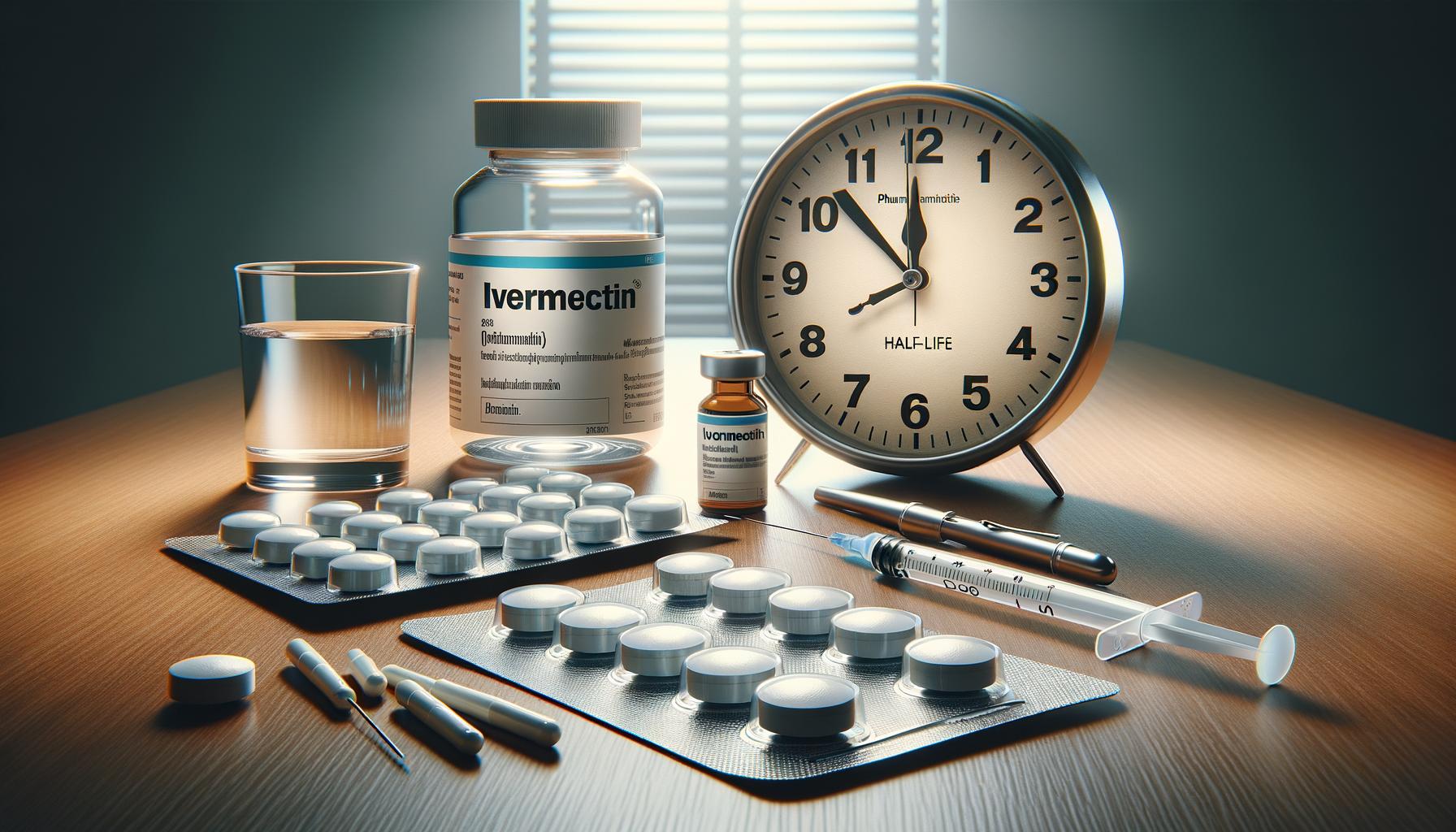Did you know that the length of time ivermectin stays in your system can affect how well it works and how soon you might experience side effects? Understanding this timeline is key for anyone taking ivermectin, whether for approved uses like treating parasites or out of curiosity about its presence in the body. Ivermectin’s behavior in the body-how quickly it’s absorbed, metabolized, and eliminated-can impact safety and effectiveness. This guide will walk you through a clear, science-based timeline of ivermectin’s presence in your body, helping you grasp what to expect after a dose. By knowing how long it remains active, you can make more informed decisions and better communicate with your healthcare provider about treatment plans and potential interactions. Remember, while ivermectin has valid medical applications, it’s important to use it under professional guidance to ensure it’s safe and appropriate for your situation. Let’s explore the facts together, offering you clarity and confidence on this important topic.
How Ivermectin Works in the Body
Ivermectin acts with remarkable precision inside the body, targeting specific parasites by disrupting their internal systems without severely affecting human cells. Its key mode of action involves binding to glutamate-gated chloride channels found in the nerve and muscle cells of many parasites. By attaching to these channels, ivermectin increases chloride ion permeability, which causes hyperpolarization of the parasite’s cell membranes. This hyperpolarization effectively paralyzes the parasite, preventing it from moving, feeding, and reproducing, ultimately leading to its death.
What makes ivermectin distinctive is its selective toxicity: the drug exploits differences in receptor types between parasites and humans, allowing it to incapacitate worms and insects while generally sparing human nerve and muscle function. However, this differential effect depends on ivermectin’s limited ability to cross the blood-brain barrier in humans, which helps explain its relative safety at prescribed doses.
Beyond its antiparasitic action, ivermectin shows complex pharmacodynamics influenced by its absorption and distribution throughout the body. Once ingested, the drug is absorbed primarily through the gastrointestinal tract and distributed quickly into fatty tissues due to its lipophilic (fat-attracting) nature. This characteristic allows ivermectin to remain in certain body compartments longer, which can influence the duration of its activity and how long it stays detectable in the system.
- Selective targeting: It interferes with parasite nerve and muscle function without significantly affecting humans.
- Blood-brain barrier protection: Limits ivermectin’s penetration into the brain, reducing side effects at therapeutic doses.
- Lipophilic distribution: Deposits in fatty tissues, which can prolong presence in the body beyond immediate effects.
Understanding these mechanisms helps patients and providers appreciate not only how ivermectin combats parasitic infections but also why clearance times may vary. Always consult a healthcare professional before using ivermectin, as individual factors like body weight, liver function, and co-existing health conditions can affect both its effectiveness and duration in your system [[1]](https://www.drugs.com/monograph/ivermectin.html).
Factors Affecting Ivermectin Duration
Ivermectin’s time in the body isn’t fixed; it shifts depending on diverse personal and biological factors. One of the biggest influencers is liver function, as the liver metabolizes ivermectin before it’s cleared from the system. People with impaired liver function often experience a slower breakdown of the drug, meaning it can linger longer and potentially increase the risk of side effects. This factor is crucial because it can alter the expected duration of ivermectin’s therapeutic effects and detection time.
Other critical aspects include body fat percentage and age. Due to ivermectin’s lipophilic nature, individuals with higher body fat can store the drug in fatty tissues, causing it to release gradually over time. This slow release can extend how long ivermectin remains detectable in the body, sometimes beyond its primary action period. Similarly, age influences metabolism speed-elderly patients typically process medications more slowly, which can affect ivermectin clearance rates.
Medications taken concurrently can also play a significant role. Ivermectin interacts with many drugs-some can increase its levels in the blood by interfering with metabolism, while others might speed up clearance. For example, certain antifungal or antibiotic medications may inhibit enzymes responsible for ivermectin metabolism, prolonging its presence. This fact underscores the importance of disclosing all medications and supplements to healthcare providers to avoid unexpected interactions.
- Liver health: A key determinant of how quickly ivermectin is metabolized and cleared.
- Body fat: Higher fat content can trap ivermectin, extending its biological half-life.
- Age: Older adults generally have slower drug metabolism.
- Drug interactions: Some medications can either slow or speed up ivermectin clearance.
By understanding these variables, patients and providers can better anticipate ivermectin’s duration in the system, tailor dosing schedules, and monitor for residual effects. Always seek personalized advice from healthcare professionals before and after taking ivermectin, especially if you have underlying health issues or take other medications [[1]](https://www.drugs.com/monograph/ivermectin.html).
Complete Timeline: Ivermectin Clearance
The journey of ivermectin through your body is a dynamic process influenced by how quickly your system can metabolize and eliminate it. Typically, ivermectin’s half-life-the time it takes for half of the drug to be cleared-ranges roughly between 12 to 36 hours in healthy adults. However, this only marks the start of its clearance story. Because ivermectin is fat-soluble, it tends to accumulate in fatty tissues and slowly release over time, extending its presence beyond initial expectations.
In practical terms, most of the active drug is usually eliminated within a few days, but trace amounts may remain detectable for up to two weeks or longer depending on individual factors. For example, someone with reduced liver function may experience a prolonged presence of ivermectin, as the liver plays the primary role in breaking down the drug. Similarly, higher body fat can act as a reservoir, slowly releasing ivermectin back into the bloodstream, delaying full clearance.
Factors Influencing the Timeline
- Liver metabolism: Impaired liver function can slow the breakdown of ivermectin, extending how long it stays in your system.
- Body fat storage: Due to its lipophilic (fat-loving) property, ivermectin can be stored and released gradually from fat tissues.
- Age and overall metabolism: Older adults or individuals with slower metabolic rates may see longer clearance periods.
- Concurrent medications: Drugs that inhibit or induce liver enzymes affect ivermectin metabolism, altering clearance speed.
Understanding the Clearance Milestones
| Time After Dose | Approximate Drug Level | Clearance Status |
|---|---|---|
| 0-24 hours | Peak therapeutic levels in bloodstream | Drug absorption and initial metabolism |
| 1-3 days | Reduction to ~25-50% of peak levels | Main phase of drug elimination begins |
| 4-7 days | Traces still detectable | Continued metabolism and excretion, slow release from fat tissues |
| 7-14+ days | Minimal or undetectable | Near-complete clearance for most individuals, longer for some |
These timelines provide a general framework but remember the actual clearance timeline can differ widely. Always discuss your specific health conditions with a healthcare provider for accurate guidance.
Practical Advice for Patients
If you’re undergoing treatment with ivermectin, understanding this timeline can help set realistic expectations about how long effects or side effects may last. For instance, if you experience prolonged side effects or unexpected symptoms beyond the typical clearance window, consult your doctor. They may evaluate factors like liver health or possible drug interactions that could delay ivermectin removal.
Moreover, since ivermectin’s lingering presence could interact with other medications, avoid self-medicating or introducing new drugs without professional advice until your healthcare provider clears it. Taking this cautious approach safeguards you from adverse interactions and supports safe, effective treatment.
Ultimately, the complete clearance of ivermectin is a gradual process influenced by multiple personal factors. Recognizing this helps empower you to track your treatment progress thoughtfully and consult experts if anything unusual arises [[1]](https://www.drugs.com/ivermectin.html).
Symptoms of Ivermectin Presence in Your System
It’s important to recognize that the mere presence of ivermectin in your system does not always produce noticeable symptoms. However, some people may experience various effects while the drug is active and gradually clearing from the body. These can range from subtle to more pronounced, depending on factors like dosage, individual sensitivity, and how quickly their body metabolizes the medication.
Common symptoms linked to ivermectin’s presence often reflect its activity against parasites or interactions with your nervous system. Some individuals report mild side effects such as dizziness, fatigue, or gastrointestinal discomfort (nausea, diarrhea). Because ivermectin crosses the blood-brain barrier to a limited extent, neurological symptoms like headache or mild confusion can occasionally occur, especially if the levels remain higher for longer periods due to slow clearance.
Signs That May Indicate Ivermectin Is Still Active
- Neurological sensations: Headaches, dizziness, or lightheadedness are possible as the drug reaches peak levels and tapers off.
- Gastrointestinal issues: Mild nausea or stomach upset may persist during drug metabolism.
- Skin reactions: Some people notice temporary itching or rash, which can be related to parasite die-off or the immune response activated by ivermectin.
- Fatigue or weakness: These may occur as part of the body’s adjustment to clearing the drug and its effects.
Because ivermectin accumulates in fatty tissues and is slowly released over days, some symptoms may appear intermittently or last longer, especially in individuals with slower metabolism or impaired liver function. This delayed clearance can sometimes cause a sensation of prolonged drug effects even after the first few days.
If symptoms intensify, persist unusually long, or new concerning signs arise (like severe rash, vision changes, or pronounced neurological issues), it’s essential to seek medical attention promptly. These may signal rare but serious complications or interactions with other medications. Always inform your healthcare provider about all other drugs or supplements you are taking, as ivermectin has a moderate number of known drug interactions that can influence side effects or clearance time [[1]](https://www.drugs.com/drug-interactions/ivermectin.html).
Understanding your body’s response helps ensure safe use and timely management of any symptoms related to ivermectin’s presence. If in doubt, consulting a healthcare professional empowers you to make informed decisions and avoid unnecessary discomfort or risks.
Testing for Ivermectin in the Body
Detecting ivermectin in the body usually requires specialized laboratory testing since routine drug screens do not commonly include it. Because ivermectin is metabolized primarily by the liver and eliminated via feces and urine, its presence is most accurately measured through blood plasma concentration analysis or, less commonly, via urine tests. However, these tests are generally reserved for research settings, clinical trials, or overdose investigations rather than everyday medical practice.
How Testing for Ivermectin Works
Ivermectin levels in the bloodstream can be quantified using techniques like high-performance liquid chromatography (HPLC) or mass spectrometry. These methods allow precise detection of the drug and its metabolites, providing insight into how much ivermectin remains active or stored in the body at a given time. This is useful in cases where overdose is suspected or when monitoring drug clearance is necessary, especially in patients with impaired liver or kidney function.
When and Why Testing May Be Needed
Testing for ivermectin presence isn’t typically required in standard treatment because the drug’s pharmacokinetics (how the body processes it) and usual dosage ranges are well understood. However, tests might be ordered:
- If adverse effects are unexplained: To confirm ongoing exposure or accidental overdose.
- In clinical research: To study pharmacokinetics or drug interactions in different populations.
- In legal or forensic settings: To verify recent use or ingestion.
For most users, symptoms and history provide enough information for healthcare providers to guide treatment safely without testing.
Limitations and Practical Advice
It’s important to recognize limitations. Ivermectin has a half-life of around 12-36 hours depending on individual factors, so levels drop relatively quickly after dosing. The drug also tends to accumulate in fatty tissues, which are not routinely sampled during testing, making it harder to assess total body burden from blood tests alone. Additionally, testing availability is limited and often costly, not practical for routine confirmation of drug presence.
If you suspect you have taken ivermectin and are concerned about lingering effects or accumulation, the best course is to communicate openly with your healthcare provider rather than relying solely on drug level testing. They can interpret your symptoms in context, consider your medical history, and recommend monitoring or supportive care as needed.
In summary, testing for ivermectin presence requires specialized assays mostly applied in specialized circumstances. For everyday use, understanding dosage, timing, and bodily responses alongside professional advice will provide the safest and most practical approach to managing ivermectin treatment and its residual effects [1], [3].

Differences Between Ivermectin and Other Medications
Ivermectin stands apart from many other medications due to its unique mechanism and specific uses, especially its role as an antiparasitic agent. Unlike broad-spectrum antibiotics or antiviral drugs, ivermectin targets parasites by binding selectively to certain chloride channels in the nerves and muscles of these organisms. This causes paralysis and eventual death of the parasite, which explains its longstanding effectiveness against various parasitic infections such as roundworms, whipworms, and lice. This specificity also contributes to its generally favorable safety profile in humans, since the drug does not interact strongly with human nerve or muscle cells under standard dosing.
One notable difference related to how ivermectin behaves in the body is its relatively long half-life, typically ranging from 12 to 36 hours, which can vary based on individual metabolic factors and body composition. Unlike medications that are rapidly cleared through the kidneys, ivermectin is primarily metabolized by the liver and excreted via bile into feces, contributing to a slower elimination process. It also tends to accumulate in fatty tissues, which can extend its presence beyond what blood concentration alone might suggest. This contrasts with many drugs that remain primarily in the bloodstream and clear quickly, meaning ivermectin’s duration in the system can be longer and less immediately apparent through routine testing.
When comparing ivermectin to other antiparasitic medications, such as albendazole or mebendazole, there are clear distinctions not just in action but also in the timeline of clearance and dosing strategies. For example, albendazole has a shorter half-life and requires repeated dosing, whereas ivermectin is often given as a single dose for many parasitic infections. These differences influence how long the drugs stay active in your system and their potential for accumulation or side effects. Understanding these distinctions can help set realistic expectations about treatment duration and symptom resolution.
- Metabolism: Ivermectin relies heavily on liver metabolism and biliary excretion, unlike some drugs cleared mainly by kidneys.
- Half-life: Longer and variable half-life, impacting how long it lingers in fat tissues.
- Tissue distribution: Preferential accumulation in fatty tissues versus predominantly blood-based circulation for many drugs.
- Use cases: Targeted antiparasitic effects versus broader antimicrobial or systemic actions of other medications.
If you’ve taken ivermectin and are wondering how it compares to other drugs you may be familiar with, keep in mind these kinetic and functional differences. They impact how the medication clears your system and how quickly side effects or therapeutic benefits appear or dissipate. Always consult your healthcare provider if you have concerns or questions about how ivermectin might interact with any other medications or conditions you have. This ensures a safe, informed approach tailored specifically to your health needs.
Ivermectin Dosage and Half-Life Explained
Ivermectin’s dosage and half-life are critical factors that determine how long the drug remains active in your body and continues to exert its therapeutic effects. Typically, ivermectin is administered as a single oral dose calculated based on body weight, usually around 150 to 200 micrograms per kilogram. This tailored approach helps target parasitic infections efficiently while minimizing the risk of side effects. For example, a person weighing 70 kg might receive about 12 mg in a single dose. Some conditions, like strongyloidiasis or scabies, may require repeated dosing, but many standard infections are treated effectively with just one or two doses.
The half-life of ivermectin-the time it takes for the concentration of the drug in the bloodstream to reduce by half-ranges widely from around 12 to 36 hours. This variability depends on factors like liver function, age, and body fat percentage. The drug is primarily metabolized by the liver, then excreted mostly through the bile into the feces rather than the kidneys. This unique metabolic pathway means that ivermectin doesn’t clear as quickly as many other medications, especially those eliminated by the kidneys. Because ivermectin dissolves well in fat, it tends to accumulate in fatty tissues, which can serve as a reservoir slowly releasing the drug over time, effectively extending its presence beyond what blood concentration alone shows.
How Dosage Influences Duration
Higher doses or repeated administration can lead to longer detectable levels of ivermectin in the body, increasing both therapeutic coverage and potential side effects. However, the drug’s wide safety margin generally allows flexibility within prescribed dosing ranges without significant toxicity. It’s essential to never exceed recommended doses without medical supervision, because accumulation in fat stores is possible, especially with frequent or chronic use.
Practical Tips for Patients
- Follow Weight-Based Dosing: Accurate weight measurement ensures the correct dose for efficacy and safety.
- Be Patient With Clearance: Symptoms of parasitic infections may take days to resolve as ivermectin slowly clears and acts on parasites.
- Consult Before Re-Dosing: Avoid self-medicating or taking multiple doses without guidance, as this can affect drug levels and side effects.
| Parameter | Typical Range | Notes |
|---|---|---|
| Dosage | 150-200 mcg/kg single dose | Varies by infection type and patient weight |
| Half-life | 12-36 hours | Depends on liver metabolism and body fat |
| Primary Excretion | Biliary-fecal (mostly) | Liver metabolism crucial for clearance |
Understanding these details helps set realistic expectations about how long ivermectin works in your system and clarifies why symptoms might not disappear immediately post-treatment. If you have liver issues, altered body fat, or are on other medications, discuss with your healthcare provider as these factors can influence ivermectin’s pharmacokinetics. Always rely on professional advice for dosing and interpreting treatment outcomes to ensure safety and optimal effectiveness.[[[3]][[2]]
Potential Side Effects and Risks
Few medications strike a balance between effectiveness and safety as well as ivermectin when used correctly. However, like all drugs, it carries possible side effects and risks that vary depending on dosage, duration in the body, and individual sensitivity. Understanding these is vital, especially since ivermectin’s lingering presence in the system can influence both its benefits and drawbacks.
Most people tolerate ivermectin well at recommended doses, typically experiencing only mild and temporary symptoms. Commonly reported effects include gastrointestinal discomfort such as nausea, diarrhea, or abdominal pain, which usually subside as the body adjusts. Some may notice mild neurologic symptoms like dizziness, headache, or transient muscle aches. These reactions reflect the body’s response to the drug’s action on parasites and are not usually cause for alarm. Serious side effects are rare but can occur, particularly in cases of overdose or off-label use outside medical guidance.[[[3]][[1]]
Risks Linked to Prolonged Presence
Because ivermectin accumulates in fatty tissues and clears slowly via the liver and bile, its effects may persist longer than expected. This prolonged exposure can intensify side effects in some individuals, particularly those with liver impairment or significant body fat. Repeated or high-dose use without medical supervision increases the risk of toxicity, which may manifest as more serious neurological problems including confusion, seizures, or severe skin reactions. For example, misuse of veterinary ivermectin products has led to dangerous overdoses and adverse events, underscoring the importance of proper dosing and sourcing.[[2]]
Practical Safety Tips
- Always follow the prescribed dosage to avoid accumulation and toxic build-up.
- Notify your healthcare provider if you have liver disease or take other medications that may interact with ivermectin.
- Watch for new or worsening symptoms during and after treatment, and seek medical advice promptly.
- Avoid self-medicating or using formulations intended for animals, as these differ widely in strength and safety.
| Side Effect | Typical Severity | Notes |
|---|---|---|
| Gastrointestinal upset | Mild to moderate | Usually transient and self-resolving |
| Dizziness & headache | Mild | Observed in some patients |
| Neurologic symptoms (rare) | Serious | More likely with overdose or improper use |
| Allergic reactions | Rare | Potentially serious; requires urgent care |
By approaching ivermectin with respect and understanding its pharmacological profile, you can maximize its benefits while minimizing risks. Remember that lingering drug levels do not always equate to ongoing side effects; for most, ivermectin’s presence quietly fades as their body heals. Always engage with a healthcare professional to tailor treatment to your needs and ensure safety throughout the process.
Ivermectin and Drug Interactions
Ivermectin’s journey through the body does not happen in isolation-its interactions with other medications can significantly influence both its effectiveness and safety. A noteworthy fact is that ivermectin is metabolized primarily by the liver enzyme CYP3A4. This means drugs that affect this enzyme-either by inhibiting or inducing it-can alter how long ivermectin stays active in your system. For instance, medications like ketoconazole (a strong CYP3A4 inhibitor) may slow ivermectin clearance, potentially increasing drug levels and risk of side effects. Conversely, drugs that induce this enzyme, such as rifampin or certain antiepileptics, might reduce ivermectin’s therapeutic window by speeding its metabolism.[[1]]
Beyond enzyme interactions, ivermectin can also interplay with drugs affecting P-glycoprotein, a transporter protein that helps pump substances like ivermectin out of cells, especially in the brain. Medications that inhibit P-glycoprotein could increase ivermectin’s penetration into the central nervous system, raising the risk of neurological symptoms, especially in sensitive individuals or with high doses. This is why combining ivermectin with certain antimalarials or immunosuppressants requires close clinical monitoring.[[[3]]
Practical Guidance for Safe Use
- Inform your healthcare provider about all prescription, over-the-counter, and herbal supplements you take. This helps identify potential interaction risks early.
- Avoid self-medicating with ivermectin, particularly when using it concurrently with other medications that influence liver enzymes or drug transporters.
- Be cautious with medications impacting liver function, such as antiretrovirals, as liver impairment can both prolong ivermectin presence and amplify side effects.
- Report unusual symptoms promptly-signs like confusion, severe dizziness, or rash may indicate an adverse interaction.
| Drug Type | Interaction Effect | Potential Consequences |
|---|---|---|
| CYP3A4 inhibitors (e.g., ketoconazole) | Slowed ivermectin metabolism | Increased drug levels, higher side effect risk |
| CYP3A4 inducers (e.g., rifampin) | Accelerated ivermectin clearance | Reduced therapeutic efficacy |
| P-glycoprotein inhibitors (e.g., verapamil) | Enhanced brain penetration | Heightened neurological side effects risk |
| Hepatotoxic drugs | Impaired metabolism | Prolonged drug presence and toxicity potential |
Understanding these interactions empowers you to navigate treatments confidently. Since ivermectin’s presence in the body can linger for days, its interaction potential extends well beyond immediate dosing. Always approach combined medication use thoughtfully and collaborate with your healthcare professional to tailor a regimen that balances benefit with safety.[[2]]
Understanding Chronic Use and Accumulation
Many people wonder if taking ivermectin repeatedly or over an extended period could lead to the drug building up in the body and how that might affect safety and effectiveness. Unlike some medications that accumulate with chronic use, ivermectin has a relatively long half-life of approximately 12 to 36 hours, but it is typically cleared from the system within a few days after a single dose. This means that, under normal dosing schedules, significant accumulation is unlikely because the body metabolizes and excretes the drug efficiently between doses. However, repeated dosing or improper use could potentially alter this balance.
A key factor influencing accumulation is liver function. Since ivermectin is metabolized primarily by liver enzymes, especially CYP3A4, impaired liver health or interactions with other drugs that inhibit these enzymes can slow down metabolism. This can cause ivermectin to linger longer in the bloodstream, increasing the chances of side effects and mild drug accumulation over time. Hence, individuals with liver conditions or those taking medications affecting liver enzymes need close monitoring to prevent unwanted build-up.[[1]]
Practical Tips for Avoiding Accumulation Risks
- Follow dosing recommendations strictly: Using ivermectin as prescribed limits the potential for accumulation.
- Avoid long-term or frequent self-medication: Chronic off-label use without medical supervision can increase risk.
- Consult before combining with other drugs: Some medications can slow ivermectin clearance or affect its transport in cells.
- Inform your healthcare provider about all health conditions: Especially liver or kidney issues, which can alter how ivermectin behaves in your body.
In specific cases, such as those requiring prolonged treatment for parasitic infections, healthcare providers balance dosing intervals to maintain effective drug levels without harmful accumulation. This tailored approach underscores the importance of professional guidance when considering ivermectin use beyond a single course.
Understanding ivermectin’s pharmacokinetics helps demystify concerns about chronic use. While standard use is generally safe with minimal risk of accumulation, attention to dosing and underlying health factors is crucial to ensure continued effectiveness and safety. Always consult your healthcare professional for personalized advice before starting or continuing ivermectin therapy.
What to Expect After Taking Ivermectin
Ivermectin begins working soon after ingestion, but the way it moves through your body can create a range of experiences you might notice. Typically, the drug is absorbed relatively quickly, reaching peak levels in your bloodstream within a few hours. From there, its effects start to take hold, targeting parasites or whatever condition it’s prescribed for. However, because it is metabolized and eliminated over a day or two, you can expect its presence and influence to diminish noticeably within about 3 to 4 days after a single dose.
Many people wonder if they will feel side effects or what symptoms might indicate the drug is still active. Generally, mild and temporary symptoms such as dizziness, nausea, or mild skin reactions can occur; these usually resolve as the drug leaves your system. If you experience more severe reactions-like intense itching, swelling, or neurological symptoms-contact your healthcare provider immediately. These could suggest an unusual sensitivity or an interaction with other medications you may be taking.
What Happens During Clearance?
- Initial absorption: Ivermectin levels rise within 3 to 4 hours post-dose, where you might start noticing its therapeutic effects.
- Peak effects: The strongest impact occurs within the first day, when the drug concentration in your blood is highest.
- Metabolism and elimination: Liver enzymes break ivermectin down and your kidneys help excrete it; this process usually completes within 72 to 96 hours.
- Decline in activity: After about 2 days, most of the drug is cleared, but small amounts may linger depending on dosing and individual metabolism.
It’s important to stay hydrated and rest while your body processes the medication. Avoid alcohol or other substances that strain liver function, as they can potentially slow clearance. In rare cases where ivermectin must be taken repetitively, healthcare providers carefully monitor patients to prevent accumulation that might increase side effects.
Finally, remember that how you feel after taking ivermectin depends on factors such as your overall health, liver function, and any other medications you’re using. If you’re uncertain about symptoms or the timeline of ivermectin’s effects in your body, a quick consultation with your doctor can provide clarity and peace of mind based on your personal health profile.
Faq
Q: How does body fat affect how long ivermectin stays in your system?
A: Body fat can extend the time ivermectin stays in your system because ivermectin is lipophilic, meaning it stores in fat tissues. Individuals with higher body fat may experience slower drug clearance, which can prolong the presence of ivermectin’s effects. Monitoring is advised if dosage adjustment is needed for safe use.
Q: Can ivermectin be detected in urine or hair tests after use?
A: Ivermectin is mainly detected in blood and sometimes in urine shortly after use, but is not commonly found in hair tests. Urine testing can reveal ivermectin presence for a few days post-dose, while hair testing is not a standard method for ivermectin detection.
Q: Why might ivermectin stay longer in patients with liver impairment?
A: Liver impairment slows down ivermectin metabolism, resulting in longer retention in the body. Because the liver processes ivermectin, compromised liver function reduces clearance rates, requiring careful dosage and monitoring to avoid accumulation and toxicity.
Q: How long should you wait to take another dose of ivermectin safely?
A: Typically, it is recommended to wait at least one to two weeks before retaking ivermectin. This allows the drug to clear from your system, minimizing risk of side effects and accumulation. Always follow medical advice for dosing schedules tailored to your condition.
Q: What factors could cause ivermectin to stay in your system beyond the expected timeline?
A: Factors like age, kidney or liver disease, high body fat, and concurrent medications can prolong ivermectin clearance. Individual metabolism varies, so these factors delay elimination and increase the window of drug activity and detection.
Q: Can ivermectin’s presence in your system affect other medications long-term?
A: Yes, ivermectin can interact with certain medications during its presence, potentially amplifying side effects or reducing efficacy. Because it stays in the body for days, consult your healthcare provider about all drugs you take to avoid dangerous interactions.
Q: When is ivermectin completely undetectable after a single dose?
A: Ivermectin is typically undetectable within 3 to 4 days after a single dose in healthy adults, but this varies with individual factors. Understanding this timeline helps in planning treatments and follow-up testing safely.Q: How can hydration and diet influence the duration ivermectin remains active?
A: Staying well-hydrated and maintaining a balanced diet supports kidney and liver function, helping ivermectin clear faster from your system. While these don’t drastically shorten the timeline, they promote overall metabolic health and drug elimination efficiency.
For deeper insights, refer to sections like Factors Affecting Ivermectin Duration and Ivermectin Dosage and Half-Life Explained in the main article. Always consult a healthcare professional before making changes to your medication regimen.
The Conclusion
Understanding how long ivermectin stays in your system is key to making informed health decisions. While its presence varies based on dosage, metabolism, and individual factors, knowing its timeline empowers you to manage treatments safely and effectively. If you have any lingering questions or concerns, consulting a healthcare professional is always the best next step.
To deepen your knowledge, explore our related resources on ivermectin interactions, safe usage guidelines, and alternative treatments. Don’t forget to subscribe to our newsletter for the latest updates on medications and health insights. Engaging with our community through comments or sharing your experience can also help others navigate their own health journeys with confidence.
Stay informed, stay safe, and continue exploring topics like ivermectin clearance times, drug interactions, and recommended medical consultations right here. Your trusted source for clear, science-backed health information is just a click away.





